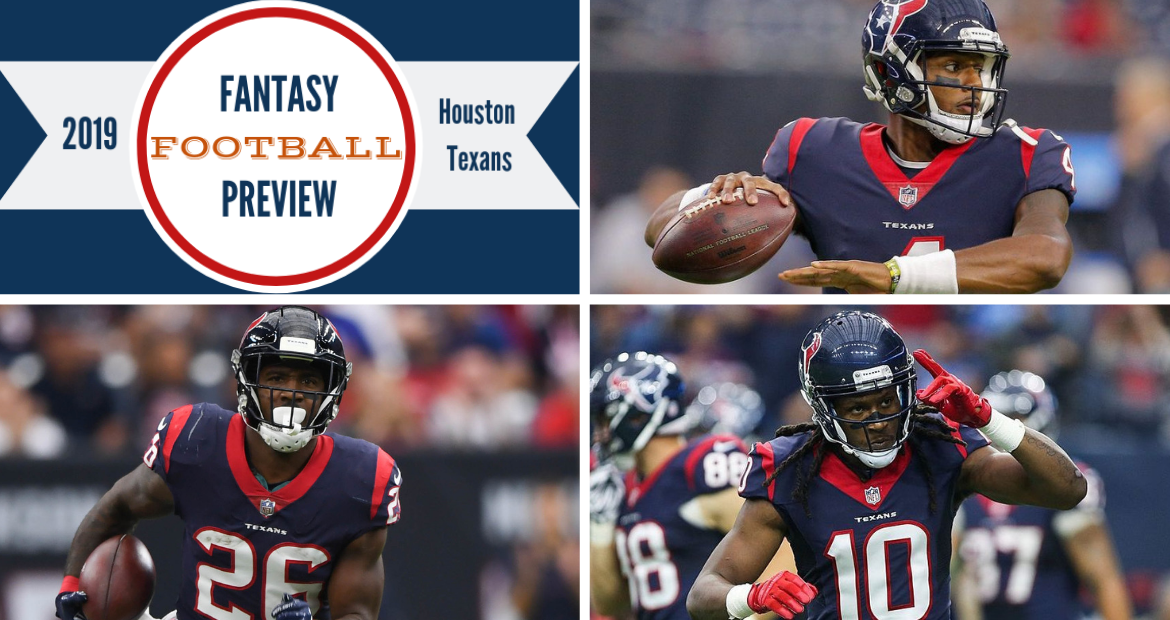
Fitz on Fantasy: 2019 Houston Texas Buying Guide
With the preseason nearing, TFG fantasy expert Pat Fitzmaurice is breaking down the prospects for all 32 teams, beginning with the AFC South. Click here to read about the Titans, Colts and Jaguars, Check back daily for new team previews. On to Houston…
The surgeon general warns that drafting a quarterback early in a one-QB league is hazardous to the health of your won-loss record. The risks associated with drafting quarterbacks early in 2QB and superflex formats are less severe, and if you’re going to light one up in the early rounds, Deshaun Watson can take you to flavor country.
Watson finished QB4 in fantasy scoring last year in his first full season as an NFL starter. He ranked sixth in passer rating, sixth in yards per attempt and third in QB rushing yards. As a rookie in 2017, Watson threw for 1,472 yards and 18 TDs over a spectacular five-game stretch before tearing his ACL in a midweek practice. Though it’s still early in his career, Watson has given us no reason to doubt his abilities.
Patrick Mahomes is the consensus QB1, which is hard to argue with after his sensational rookie year (though the prospect of a Tyreek Hill suspension has some people considering other QB1 candidates). The QB2 choices are Watson, Andrew Luck, Aaron Rodgers and (for some) Baker Mayfield. Watson would be my choice. He’s most dangerous runner from that group, and his WR corps is potentially among the best in the league if everyone stays healthy. In 22 starts, Watson has passed for 300 or more yards seven times and has run for 40-plus yards 10 times.
It’s mildly worrisome that the Texans gave up 62 sacks last year, and the Texans haven’t done much to buttress their offensive line. Still, Watson’s dual run-pass upside is incredibly enticing. There aren’t many other quarterbacks capable of hitting Yahtzee in a given week the way Watson can.
Maybe DeAndre Hopkins has undertipped a waitress or a deliveryman at some point, or failed to adequately wipe his shoes before walking on someone’s carpet. Someone, somewhere, probably has beef with Hopkins about something. But damn, it’s hard to find anyone in the fantasy realm with a bad word for the man nicknamed “Nuk.”
Hopkins has finished top-three in fantasy scoring among wide receivers in three of the last four years, with the one miss being 2016, when he was trying to haul in off-target flutterballs from Brock Osweiler. Over the last two seasons, Hopkins has averaged 6.8 catches, 95.2 receiving yards and 0.77 receiving yards per game.
There aren’t too many nits to pick with Hopkins, a player whose divine skill set is conspicuous every time he takes the field. It’s possible that his target share (a monstrous 32.2% last year) could take a hit if Will Fuller and Keke Coutee both stay healthy, but Hopkins is pretty foolproof. I have him ranked WR2 behind Davante Adams, but the Adams-Hopkins decision is basically a coin flip. Hopkins is one of the safest first-round picks you can make.
Fuller and Coutee are both intriguing fantasy commodities, but they’re as breakable as wine glasses. The risk-reward proposition with Fuller is particularly enticing. He and Watson have made some memorable music together, but even the Sex Pistols had more songs in their catalog. In 11 games with Watson, Fuller has 45 receptions for 782 yards and 11 TDs.
Fuller tore his ACL in late October of last year and has also dealt with hamstring, collarbone, rib and other knee injuries. The Texans are expecting Fuller to be ready for Week 1, and they exercised their firth-year option on him, making the commitment to pay him about $10 million for 2019. It’s one thing to take the leap of faith that Fuller will stay reasonably healthy this year, but it’s hard to see Fuller providing consistent numbers week to week when he has to defer to a target hog like Hopkins while also sharing with a tertiary receiver as talented as Coutee. Fuller’s track speed and proven HR-hitting ability make him an attractive option in best-ball leagues, but I’m avoiding him in season-long leagues because his big weeks are apt to be bookended by multiweek periods of drought.
Coutee flashed exciting potential in his rookie season, making a splash with an 11-catch, 109-yard game against the Colts in his Week 4 NFL debut and then piling up 11 more catches for 110 yards and a TD in Houston’s playoff loss to Indy. But Coutee was plagued by hamstring injuries throughout the season and played only six games.
As with Fuller, the concern with Coutee is less about durability than target competition. The presence of Hopkins keeps the target ceiling low. And unlike Fuller, a vertical receiver who averaged 15.7 yards per catch last year, Coutee is a short-area receiver who averaged 10.3 yards per catch in 2018 and had an average depth of target of 5.5 yards. While Fuller is capable of making his weekly quota on just a handful of catches, Coutee’s productivity depends largely on target volume, and it’s hard to see him getting adequate volume in light of the in-house target competition.
Houston isn’t the place to shop for either skiwear or tight ends. Jordan Thomas had 20 catches for 215 yards and four TDs last year as a rookie, and rookie third-rounder Kahale Warring has enticing athleticism, but both are just dynasty stashes at this point with minimum redraft appeal.
Lamar Miller is the ham sandwich of running backs. He’s reasonably fortifying but in no way exciting. Funny how it’s turned out that way when just a few years ago, fantasy owners were ready to picket Dolphins headquarters to demand that Miller get more touches.
Miller has put up more than 1,100 yards from scrimmage and least six touchdowns for five consecutive seasons. His half-point-PPR finishes over that span have been RB9, RB5, RB18, RB16 and, last year, RB22.
Sure, it’s possible that D’Onta Foreman, who tore his Achilles tendon 19 months ago, is now fit enough to steal some early-down work from Miller. But the Texans have reason to be judicious in managing Foreman’s workload, and pass catching isn’t part of his résumé. The usage floor for Miller looks reasonably sturdy, since even in a worst-case scenario he’ll handle the passing-down work and get a minority share of early-down work. More likely, he’ll have a fourth consecutive season of 200-plus carries for the Texans and returns RB2 value for an RB3 price. I’ve been an avid buyer of Miller in early best-ball drafts and consider him a value relative to expert consensus and ADP. (And I like my ham sandwich with Swiss cheese and mustard, thank you.)
The public fascination with Foreman is somewhat understandable: He’s big and fast and had a 2,000-yard rushing season in his final college season at Texas. Foreman was getting about 10 carries a game as a rookie when he tore his Achilles on the second TD run of his career (and his second TD against the Cardinals that day). He made two brief appearances late last season, and the team is saying all the right things about Foreman’s continued progress.
Few running back have successfully come back from a torn Achilles. Mikel Leshoure tore his in August of 2011, his rookie year, then ran for 798 yards and nine TDs in 2012, but he would only play three more NFL games after that. Edgar Bennett missed the 1997 season with a torn Achilles, then had a team-high 611 rushing yards for the Bears in 1998, but he had only six carries in 1999 before retiring. Andre Brown blew out his Achilles in 2009, then made modest contributions to the Giants in 2012 and 2013. It’s an injury that effectively ended the careers of Arian Foster, Beanie Wells, Vick Ballard, LenDale White and others.
But I’m actually less troubled by the Achilles thing than by the one-dimensional nature of Foreman’s game. He had 13 catches during his three college seasons, then six catches in nine games as a rookie. Foreman is also poor pass blocker, so he’s not going to play much on obvious passing downs. Even when Foreman was getting carries in 2017, there was only one game in which he played more than 30% of Houston’s offensive snaps. There are better fliers to be taken at the RB position.
| PLAYER | FITZ RANK | ECR | ADP | ADVICE |
| Deshaun Watson | QB2 | QB3 | QB4 | Buy in 2QB |
| Lamar Miller | RB26 | RB27 | RB31 | Good value |
| D’Onta Foreman | RB48 | RB47 | RB43 | Long Shot |
| DeAndre Hopkins | WR2 | WR1 | WR1 | Foolproof |
| Will Fuller | WR38 | WR33 | WR32 | Too pricy |
| Keke Coutee | WR50 | WR46 | WR49 | Rain check |
| Jordan Thomas | TE40 | TE39 | TE48 | Dynasty only |
ADP = Average Draft Position ECR = Expert Consensus Ranking



